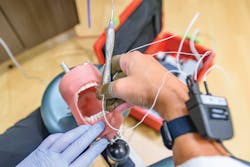Get the upper hand: Ergonomic strategies to avoid musculoskeletal injuries
Dentistry has been presented with many long-standing lessons during the COVID-19 pandemic, but none more solid than the realization that to thrive as essential health-care professionals, we must be fluid, flexible, and continually open to evolving recommendations and regulations. This paradigm shift has forced us to alter how we deliver optimal clinical care for the sake of our health and that of our patients. It is time to re-embrace hand scaling and call upon new prevention strategies to improve our musculoskeletal health and to reduce our risk of work-related injuries. As we get back to basics, it’s more important than ever to observe and implement fundamental ergonomic principles for a healthy practice, which include incorporating instruments with science-based design into our armamentarium.
Scale up!
Our profession has stepped up to adopt changes for infection control to protect the health and safety of practitioners and patients, but shouldn’t we also look at opportunities to improve our personal health and the overall patient experience? The American Dental Hygienists’ Association (ADHA) supports Centers for Disease Control and Prevention (CDC) recommendations that state we should “balance the need to provide necessary services while minimizing risk to patients and health-care personnel.”1 It’s well-known that dental practitioners are at an elevated risk of developing work-related musculoskeletal disorders (WMSDs) of the upper extremity.2 According to certified occupational therapists, “One ergonomic component that may contribute to reducing the onset of WMSDs of the upper extremity in dental hygienists are ergonomically designed instruments; specifically, scalers.”3 With hand scaling and root planing accounting for approximately 31.3% of standard prophylactic procedures,2 it is imperative that a hand scaler be ergonomically designed for the comfort of the operator and the patient alike. It’s time to base our hand instrument selection on new and relevant science.
Ergonomics: What’s in it for me?
Focusing on ergonomics means finding the best possible match for the greatest number of people by adapting a product to fit the user rather than vice versa.4 The worst problems developed by hygienists are often associated with repeated gripping and turning actions executed with the wrist in a deviated position. According to Hayes, et al., the hand and wrist regions were the most prevalent areas of pain for dental hygienists (60-69.5%).”2
Common shoulder, elbow, and hand disorders of dental hygienists:3,5
- De Quervain’s tenosynovitis
- Carpal tunnel syndrome
- Trigger finger
- Osteoarthritis
- Thoracic outlet syndrome
- Lateral epicondylitis (tennis elbow, ulnar nerve entrapment)
- Ganglion cyst
- Trigger points
There is a misconception that the design of ergonomic products is intuitive, allowing users to rely on common sense in the evaluation and purchase of these products. In fact, the past definition of an ergonomically designed dental instrument was based heavily on assumptions instead of test data and empirical studies.
A scientific approach to ergonomics
A leading-edge, innovative study compared Harmony Ergonomic Scalers and Curettes from Hu-Friedy, now a part of HuFriedyGroup, to other scalers and curettes currently available. The study measured participants’ resultant pinch force on a given handle while scaling and the associated scaling force applied to a tooth.6
To advance the understanding of ergonomics, HuFriedyGroup developed TrueFit Technology, a sensor-based system to identify key measures of ergonomics with dental instruments. The study collected 2,878,320 data points, which were analyzed by an unbiased analytics firm outside the dental industry.6
Results showed a significant improvement over the other brands tested. The Harmony Ergonomic Scalers and Curettes exhibited an average of 55% reduction in total pinch force of the thumb, middle, and index fingers and an average of 31% reduction in pressure applied to the tooth surface.6
Hand relief down to a science
Reducing the amount of pinch force dental hygienists apply to a scaler can go a long way toward preserving career longevity by helping to decrease the onset of muscle fatigue. Prolonged exposure to muscle fatigue can lead to inflammation, and this inflammation can cause hand disorders and injuries. Reducing pinch force removes a key component that can cause serious injuries which impact not only hygienists’ careers, but personal lives as well.
Furthermore, improving the patient experience is something every hygienist strives to achieve. Reducing pressure applied to the tooth means increased comfort for patients during scaling procedures.
The new standard
Take a hand in improving your health and advancing the ADHA Standards for Clinical Dental Hygiene Practice. It is more crucial now than ever before to adhere to the Professional Responsibilities and Considerations:7
- Maintain awareness of changing trends in dental hygiene, health, and society that impact dental hygiene care.
- Access and utilize current, valid, and reliable evidence in clinical decision-making through analyzing and interpreting the literature and other resources.
- Prevent situations where patient safety and well-being could be potentially compromised.7
This HuFriedyGroup study is an in-depth exploration of the complexity of scaling, with attention to the hygienist’s exertion and to the pinch force necessary to remove calculus from a tooth. Extensive testing demonstrated that an advanced ergonomic design delivers significant benefits for comfort without sacrificing effectiveness.6 We now have a baseline for comparing future ergonomically designed instruments.
Editor's note: Both authors are key opinion leaders for HuFriedyGroup.
References
- ADHA interim guidance on returning to work. American Dental Hygienists’ Association (ADHA). August 5, 2020. Accessed September 24, 2020. https://www.adha.org/resources-docs/ADHA_TaskForceReport.pdf
- Hayes M, Cockrell D, Smith DR. A systematic review of musculoskeletal disorders among dental professionals. Int J Dent Hyg. 2009;7(3):159-165. doi:10.1111/j.1601-5037.2009.00395.x
- Kulpa-Lindgren K, Chang S. 2020. The importance of instrument handle design in dental hygiene in relation to work-related musculoskeletal disorders. In press.
- Pheasant S. Ergonomics, work and health. Palgrave; 1991:14. https://doi.org/10.1007/978-1-349-21671-0
- Valachi B. Practice dentistry pain free: Evidence-based strategies to prevent pain and extend your career. Posturedontics Press; 2008:75-78.
- White paper: The ergonomic implications of scaler design for hygienists and patients. HuFriedyGroup. 2020.
- Standards for clinical dental hygiene practice. ADHA. Updated 2016. Accessed August 25, 2020. https://www.adha.org/resources-docs/2016-Revised-Standards-for-Clinical-Dental-Hygiene-Practice.pdf
About the Author

Cindy M. Purdy, BSDH, RDH, CEAS
Cindy M. Purdy, BSDH, RDH, CEAS, has a passion for workplace wellness that has resulted in the creation of THRIVE, a dental-oriented wellness and therapeutic alternatives summit for dental professionals. THRIVE occurs three to four times annually at Glen Eyrie Castle in Colorado Springs, Colorado. Attendance information can be found at cindypurdy.com. In addition to multiple decades as a clinical dental hygienist, Cindy holds an ergonomic certification from Colorado State University, a certified ergonomic assessment specialist credential, and is certified in health-care ergonomics.

Edie Gibson, MS, RDH
Edie Gibson, MS, RDH, has a mission to affect change. With over three decades of clinical and business expertise in dentistry, she opened About Face DH Spa in Crested Butte, Colorado, the first independent hygiene practice in Gunnison County. When spinal surgery ended her clinical career, she set out to empower other hygienists to own their profession and embrace proper ergonomic principles to help them avoid a similar fate. She is passionate about dentistry and inspiring other hygienists to take the leap into independent practice and public speaking.

